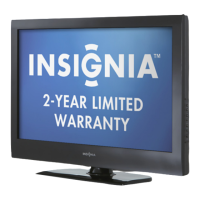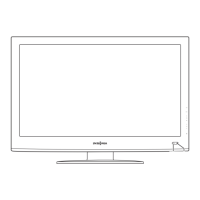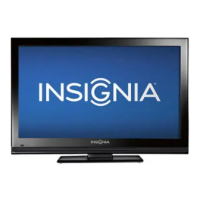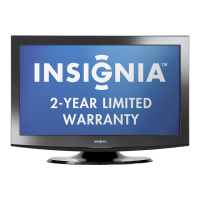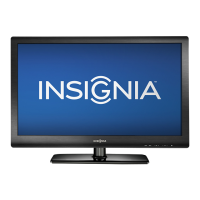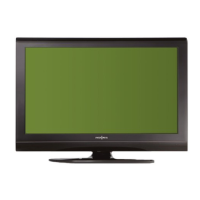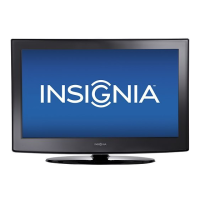Do you have a question about the Insignia NS-32D312NA15 and is the answer not in the manual?
Discusses safe placement of TVs to prevent injury.
Explains symbols for voltage and important operating instructions.
Advises unplugging during lightning storms and warns about power line proximity.
Precautions for broken LCD panels and using specified replacement parts.
Routine safety checks after service and operating from the correct power source.
Conditions requiring qualified service personnel and damage warnings.
Importance of grounding and advice on preventing condensation.
Mobile phone warning, end-of-life directives, and non-active pixels.
Connect MHL-enabled devices and use Roku Streaming Stick.
HDMI CEC control, sound features, and game mode optimization.
Steps to securely attach the TV stand.
Notes on wall-mounting the TV with a UL-listed bracket.
Lists items included and identifies front components.
Details the buttons on the right side of the TV.
Identifies and describes audio, USB, and video ports on the left.
Identifies power, audio, video, and antenna inputs on the back.
Steps for inserting batteries into the remote control.
Details the purpose of each button on the remote control.
Illustrates common video/audio connection types and their cables.
Guides on choosing the best connection type for video quality.
Instructions for connecting via HDMI for optimal quality.
Connects DVI devices, requiring a separate audio connection.
Connects component video devices for improved quality.
Connects composite video devices for standard quality.
Connects coaxial cables for antenna or cable TV.
Connects antennas or cable TV directly without a set-top box.
Connects DVD/Blu-ray players via HDMI for best quality.
Connects DVD/Blu-ray players via component video.
Connects DVD/Blu-ray players via composite video.
Connects game consoles via HDMI for best quality.
Connects game consoles via component video.
Connects game consoles via composite video.
Connects computers via HDMI for optimal display.
Connects computers via DVI with separate audio.
Connects computers via VGA for video display.
Connects a Roku Streaming Stick for streaming content.
Connects MHL devices like phones to view content on TV.
Connects headphones to listen to TV audio.
Connects external devices via digital optical audio.
Connects external devices via analog audio output.
Illustrates connections for a multi-device home theater setup.
Instructions for connecting the TV's power adapter.
Guides through initial TV setup and configuration.
Configures language, time zone, and viewing environment.
Chooses the primary TV source and selects video input.
Basic operation of powering the TV on and off.
Explains the structure and navigation of the TV's menus.
Instructions on using buttons to navigate menus.
How to tune to channels using direct entry or favorites.
How to adjust volume, mute, and view program details.
How to connect and navigate a Roku Streaming Stick.
How to connect and view content from MHL devices.
How to switch between Roku and MHL interfaces.
Controls connected HDMI CEC devices and enables/disables INlink.
How to switch back to other HDMI inputs.
Automates power management for CEC devices.
Controls audio receiver volume and displays INlink device lists.
Chooses which CEC device to control and accesses its root menu.
Connects USB drives and enters USB mode.
Navigates and views photos from the USB drive.
Browses favorite photos and displays them in a slideshow.
Adjusts slideshow options like repeat, shuffle, speed.
Fine-tunes picture settings like mode, brightness, contrast.
Selects presets and adjusts picture elements like color and sharpness.
Accesses advanced video settings like Overscan and Aspect Ratio.
Adjusts image quality when connected via VGA.
Fine-tunes sound settings for optimal audio.
Selects sound modes and adjusts balance, bass, treble.
Controls TV audio playback and selects audio output modes.
Turns off the picture to listen to audio only.
Manages channel settings and scanning.
Guides connection types for cable/satellite boxes.
Skips channels in the channel list.
Creates and accesses a list of preferred channels.
Assigns custom names to channels for easier identification.
Checks signal strength for digital channels.
Sets or modifies the parental control password.
Locks physical buttons on the TV.
Blocks TV programs without ratings.
Configures rating restrictions for US and Canadian content.
Downloads program rating data for parental controls.
Resets parental controls to default settings.
Enables or disables closed captioning display.
Chooses display modes for analog closed captions.
Chooses display modes for digital closed captions.
Adjusts appearance of digital closed captions.
Configures the TV's date and time.
Sets the TV to turn off automatically after a set time.
Changes the on-screen menu language.
Assigns custom names to input sources for easier identification.
Controls automatic input detection.
Instructions for cleaning the TV exterior and screen.
Resets all TV settings to factory defaults.
Displays system details and provides firmware update instructions.
Common issues with picture and sound, and their solutions.
Solutions for picture problems like lines, dark spots, or no picture.
Troubleshooting audio noise and lack of speaker output.
Troubleshooting remote control and programming universal remotes.
Steps to resolve no power issues and 'No signal' display.
Resolving missing channels and grayed-out input sources.
Procedures for password recovery and inaccessible settings.
Explains normal cabinet creaking and unresponsive buttons.
Troubleshooting unexpected TV turn-offs and exiting retail mode.
Resolving no picture, no sound, or streaming issues with Roku Stick.
Troubleshooting charging and display issues with MHL devices.
Troubleshooting video, audio, remote control, and device list issues with INlink.
Manages device power on/off, audio receiver control, and menu access.
Physical size, weight, and screen technology specifications.
Supported resolutions, tuner types, and available ports.
Details on sound, power consumption, OSD languages, and INlink.
Instructions for programming universal remotes to control the TV.
Lists codes for various remote control brands.
Regulatory compliance information for FCC and Industry Canada.
Information on Dolby, HDMI, DTS, MHL, Roku, and ENERGY STAR.
Defines warranty duration, coverage, and exclusions.
Steps for contacting support and getting service.
| Comb filter | 3D |
|---|---|
| Screen shape | Flat |
| Response time | 8 ms |
| Display diagonal | 31.5 \ |
| Display brightness | 160 cd/m² |
| Display resolution | 1366 x 768 pixels |
| Display technology | LED |
| Native aspect ratio | 16:9 |
| Native refresh rate | 60 Hz |
| LED backlighting type | - |
| Supported video modes | 480i, 480p, 720p |
| Contrast ratio (dynamic) | 500000:1 |
| Contrast ratio (typical) | 800:1 |
| Tuner type | Analog & digital |
| Analog signal format system | NTSC |
| Digital signal format system | ATSC |
| Product color | Black |
| Panel mounting interface | 200 x 200 mm |
| RMS rated power | 10 W |
| Number of speakers | 2 |
| Headphone outputs | 1 |
| USB 2.0 ports quantity | USB 2.0 ports have a data transmission speed of 480 Mbps, and are backwards compatible with USB 1.1 ports. You can connect all kinds of peripheral devices to them. |
| USB 3.2 Gen 1 (3.1 Gen 1) Type-A ports quantity | 0 |
| Power consumption (standby) | 1 W |
| Power consumption (typical) | 60 W |
| Depth (with stand) | 180 mm |
|---|---|
| Height (with stand) | 483 mm |
| Weight (with stand) | 4800 g |
| Depth (without stand) | 82 mm |
| Width (without stand) | 744 mm |
| Height (without stand) | 443 mm |
| Weight (without stand) | 4500 g |


